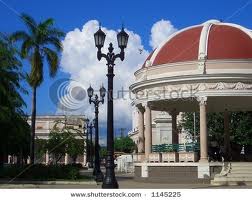

We opt for Cienfuegos, based in part on the recommendation of a traveling Italian couple we keep bumping into. Cienfuegos is a complete contrast to Trinidad. Cienfuegos is sophisticated, feels “rich”, has a large square with an 1889 theater that is remindful of Buenos Aires’ grand teatro. More surprisingly, Cienfuegos has a vibrant commercial street with many shopping options and a thriving economy.
A bookstore, selling books in moneda nacional, typically reserved for Cubans, is a window into the intellectual side of Cuba. Perhaps as a result of the high level of literacy, or simply due to the absence of enticing TV offerings and near absence of internet, literature has emerged as a national passion perhaps as great as dancing and music. We return home with a stack of books, in Spanish of course, which we hope to delve into once we are back home.
My (Ben) best find: Sandinismo en Nicaragua, a 400 page treatise on what Sandinismo was and is today in Nicaragua. Peta’s find: some easy reading in Spanish to practice with, and a very interesting English summary of the past 100 years that is thought provoking in its distillation of Latin American movements of independence and the recurring and brutal pattern of subjugation by US military troops in Guatemala, Honduras, Nicaragua, Cuba, El Salvador, Panama, Puerto Rico, Dominican Republic, Haiti and Colombia.
We tour the city of Cienfuegos by horse-cart taxi. We cannot find a Casa Particular. Not many tourists visible in town, but all of the Casa Particulares seem full.
We ultimately find a room connected to a restaurant overlooking the Prado, the main tree lined boulevard that intersects the town.The large balcony offers an ideal location to have lunch and write our blog.
We get an education on the peculiar approach to real estate transactions in Cuba. The most important concept is permutacion” – i.e. trading one’s house for another, with no cash changing hands, as long as the owners are in agreement.In this case, the young couple had maxed out its newish house and awaiting children, wanted to find a larger place. Conversely, the beautiful 2 story building, while much larger, needed extensive renovation and had a steep set of stairs, something undesirable to the now aging owners, who wanted something that did not require climbing stairs. The exchange was executed to both parties satisfaction and the deal was formalized 2 years ago, just in time for the young couple to get a loan from their family to renovate the house just ahead of a change in the law that now allowed them to open a restaurant.


The highlight and surprise of Cienfuegos is a chance walk past a local dance company of youth from 7 to 20 years old. The quality and level of modern dance is exceptionally high.
We get to chat with the choreographer and it is a good opportunity to learn about the dancers’ regimen. 6 days a week, 3 hours a day of practice, after school. The dancing is sultry, sensuous bordering on strip-tease type moves, done by boys and girls… under the proud eyes of parents and grandparents. Nothing like that would be seen in the U.S. as the US moral brigades would be up in arms about the sexualization of children. Be that as it may, this seemed perfectly normal and culturally consistent with the flirtatious nature of Cubans and their affinity for dance and rhythms.
